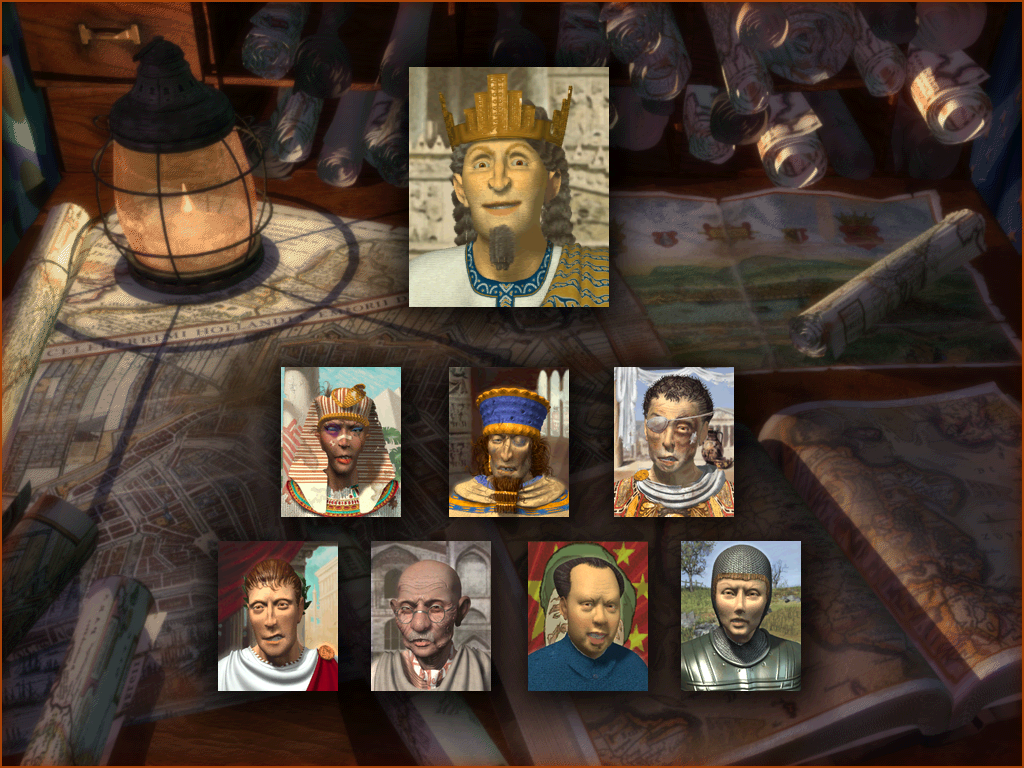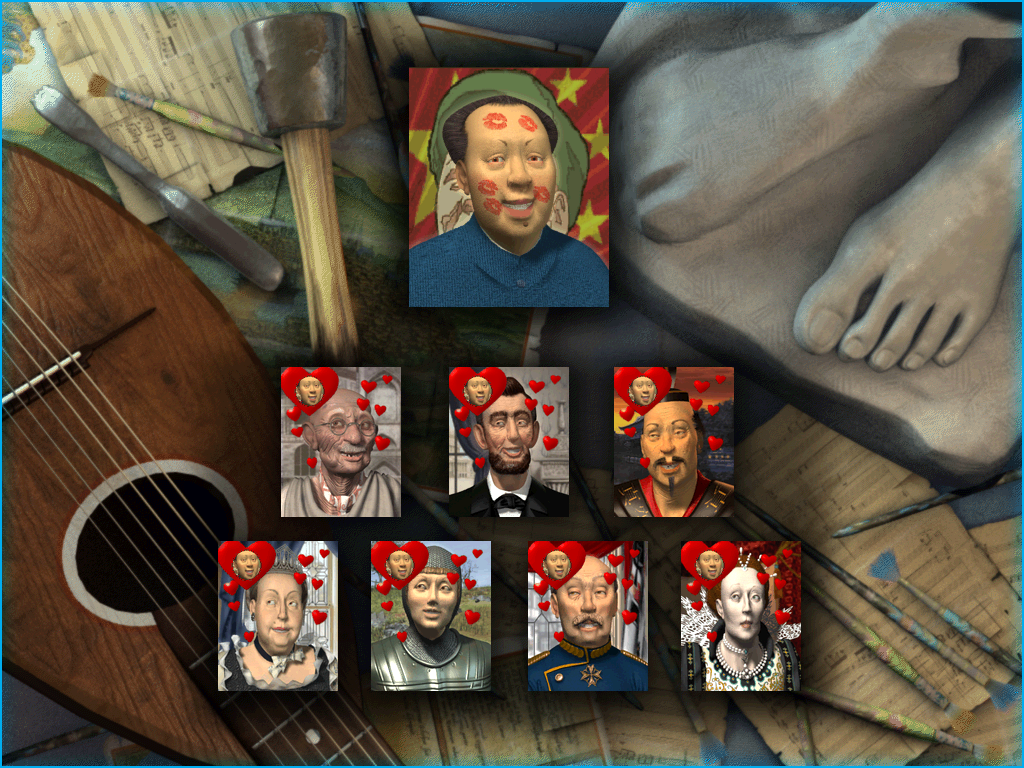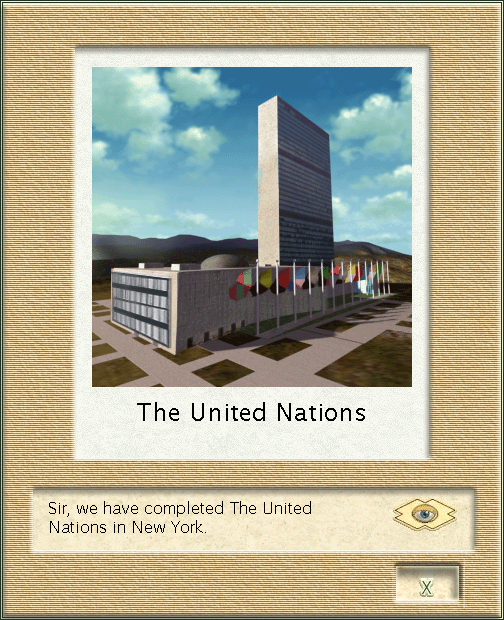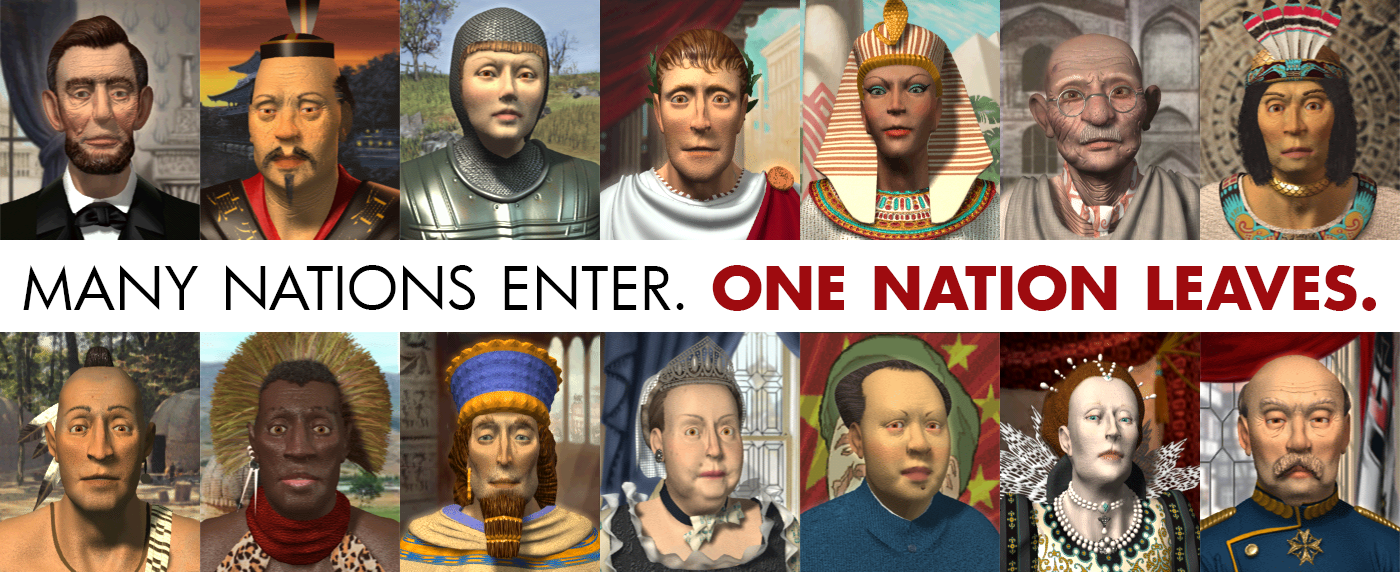Games in Sid Meier’s Civilization series are loosely patterned off the rise and fall of real-life civilizations. And some of these real-life civilizations had exactly the kinds of ambitions that would win a game of Civilization. Which raises the obvious question: did any of them get close? Has anybody won? Are we all just living in the “just a few more turns” postgame of a real-life Civilization match?
(“Yes,” “maybe,” and “maybe.”)
This is about who got closest, although in a couple cases, there may already be a winner. And I’ll be using the victory conditions from Civilization III. Because I like Civilization III and it’s the best one.
All images are either screenshots from Sid Meier’s Civilization III, or composites generated from in-game image assets. Presumed fair use for commentary purposes.
Conquest and/or Domination Victory—Achaemenid Empire, 500 BCE
 For a Conquest victory (in any Civilization game), simple conquer and/or destroy every single other civilization, bringing every person on earth under your civilization’s rule. Civ III‘s Domination victory was essentially Conquest-lite (with a territory requirement tossed in): take 2/3 of the world’s territory, and control 2/3 of the world’s population.
For a Conquest victory (in any Civilization game), simple conquer and/or destroy every single other civilization, bringing every person on earth under your civilization’s rule. Civ III‘s Domination victory was essentially Conquest-lite (with a territory requirement tossed in): take 2/3 of the world’s territory, and control 2/3 of the world’s population.
No real-world civilization has ever controlled 2/3 of the total land surface area. The British Empire came the closest in the early 1900s, controlling almost 23% of the globe by 1922. But with only 20% of the world’s population, they were still far, far away from the 66% of each needed for Domination.
The Mongol Empire, though slightly smaller by area at its peak (less than 0.5% smaller), controlled 25.6% of the population. Given a weighted average of both land area and population, the Mongols were closer to a Domination victory than the British.
But the Achaemenid (or Persian) Empire puts them both to shame. While only conquering 5.4% of the land in 500 BCE, but they boasted a whopping 44.5% of the people! The Achaemenid Empire was nearly halfway to a real-life Conquest victory . . . and despite its small land holdings, the closest in history to a Domination victory as well.
Space Victory—USA, 1969-1972
https://www.youtube.com/watch?v=21q3yoE84es
If you wanted to win Civilization III without killing anybody (or just to keep the killing to a minimum) the Space victory was a great option. Just launch a colony ship full of humans to Alpha Centauri (which, unknown to Sid Meier at the time, might actually have at least one habitable-ish planet) and viola! Victory is yours!
No civilization on Earth is anywhere near ready to build a human colony ship to Alpha Centauri, but the USA has sent humans to the moon, which is approximately 1/100,000,000 the distance to Alpha Centauri. (For comparison’s sake, by climbing a one-story flight of stairs you have traveled approximately 1/100,000,000 of the way to the moon.) So the USA’s manned Apollo missions have come “closest” to a Space victory, but not by much.
Cultural Victory—China, Probably?

Note: I actually just played an 18 hour game of Civ3 to get a screenshot of a Chinese cultural victory. And then immediately realized that I could have a better image in 15 minutes by using the raw images in the game files.
In Civilization III, you win a Cultural Victory if one city accrues 20,000 culture points, or if your whole civilization earns 100,000 culture points and at least twice the points of any other civilization’s culture points. Wonders like the Great Library of Alexandria generate 6 culture per turn . . . but with ancient cities and territory constantly changing hands (Greek Alexandria quickly fell to the Romans, then the Persians, then the Byzantines, the Islamic Caliphate, Ottomans, French, and British, and is now Egyptian) none of the real-life Wonders had time to rack up any significant culture. This is true even of China, which fell under Mongol control at just the right time to wipe out any significant bonuses they might have reaped from the Great Wall or their Iron Works.
Victory, then, hangs on the more numerous city improvements: temples, cathedrals, research labs, libraries, universities and colosseums. We could try finding reliable historical statistics on each improvement category, but there’s one obvious standout, one thing on the list that at least two ancient civilizations had in abundance, orders of magnitude beyond anything else.
Temples.
Yes, temples, worth the fewest cultural points (2) of any improvement that grants culture points. India alone has hundreds of thousands of temples: 108,000 government-recognized, plus at least 500,000 more “off the books”. China has rebuilt between 1 and 2 million temples just since 1979, all of those temples existing long before the Cultural Revolution. When you’re talking hundreds of thousands (or millions), it doesn’t make sense to even consider America’s 4,600 universities or the 467 cathedrals Italy once had. If there’s a winner out there, it’s going to be decided by temples alone.
So who wins (or at least comes closest?) While Egypt, Sumeria, and Greece had temples too, China had an order of magnitude more people than any of these other civilizations (over 100 million Chinese vs 10 million Greeks and 7 million Egyptians), an order of magnitude more towns/cities/villages, and since temples tend to be at least one per village, likely had an order of magnitude more temples
China also had a big head start on India (who had a few million more people, but wasn’t interested in building temples). While I don’t have solid numbers to back me up on this, I pick China as the most likely candidate for either outright winning a Culture Victory sometime in the BCE years, or at the very least coming closest to it.
Diplomacy Victory—Did Norway Win In 1946?

Depending on how you translate the rules of Civ III to real-life, it’s possible that Norway (not a playable civilization in any version of the game) has already won the game via diplomatic victory.
To win a diplomatic victory in Civ III, you must be elected “leader” of the United Nations . . . potentially similar to the real-life position of Secretary-General.
The first Secretary-General of the United Nations was from the UK, but he was just a temporary appointment until the post could be filled. The first person elected Secretary-General was Trygve Lie of Norway. Under the simplest reading of the victory conditions, that means Norway has already won real-life Civilization III, and has simply opted to continue playing.
But one feature of Civilization’s UN elections is that not everyone is allowed on the ballot. Contenders for UN leader must meet at least one of the following criteria:
- Build the UN (Civilization III would count the USA as having done this, as the headquarters are in New York)
- Control over 25% of the world’s land area
- Control over 25% of the world’s population
- If no civilization meets criteria #2 or #3 (and no real-life nation does), then the most-populated civilization other than #1 (China)
Thus only the USA and China would qualify to run for leader of the UN in Civilization III. But neither will likely ever have a representative serve as UN Secretary General, as real-life convention dictates that, as permanent Security Council members, no representative from either nation will be considered for the post in the future. The only two potential candidates under Civ rules don’t have a realistic shot at the office.
India, however, is not permanently on the Security Council, and India is expected to overtake China in population before 2030, which would qualify India (and disqualify China) for the ballot under Civilization rules. Barring some massive unforseen shakeup in global population and/or geopolitical boundaries, the earliest a Diplomacy victory could end the game is if an Indian representative wins the UN Secretary-General election in 2031.
Histograph—China, 2050

Civilization has a built-in time limit: if there’s no winner by the year 2050, the game ‘s over, and the winner is decided by “points”. Points are awarded based on population, territory, and happiness. The results are then displayed as a histograph a little like the one above.
The histograph above does not go back to 4000 BCE, and is based on global GDP data from the last 2000 years combined with future GDP projections by PwC. I made this chart before I bothered looking up the formula for the final score. I’m still using it because, before about 1700, “GDP” tracks pretty well with “population”.
So what will the real world’s histograph look like between 4000 BCE and 2050 CE?
China and India are obvious, obvious standouts for population and territory. Happiness (the third score criteria) is hard to find good historical data for, but even if zero Chinese and Indian people had ever been happy, their sheer population and land area would overwhelm that third component of the score for other civilizations.
Historically, the region now known as India was home to a few more people than the region now known as China (and China’s brief experiment with the Black Death in the 1200s, combined with famine and conquering Mongolian armies, temporarily halved their population) . . . but China is three times larger than India, so the small historical discrepancy between their populations would be insignificant next to the gap in their land area. Because of its large area, large population and roughly historically-stable boundaries, China should have the top score when time runs out in 2050.
This post originally appeared on the Observation Deck.

